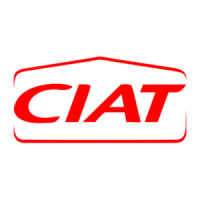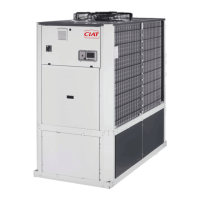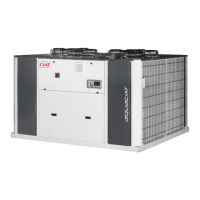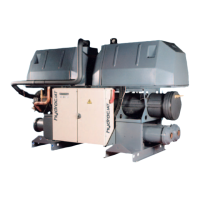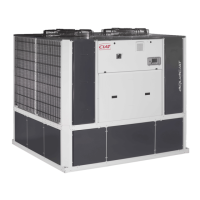
Do you have a question about the CIAT AQUACIATPOWER LD 0602R and is the answer not in the manual?
Verifying unit condition and completeness upon delivery.
Procedures for safe lifting, moving, and transporting the unit.
Requirements and considerations for placing the unit in its final location.
Unit dimensions and clearances without a water buffer tank.
Unit dimensions and clearances with a water buffer tank.
Recommended clearances for maintenance and airflow.
Safety guidelines for placing units near potential ignition sources.
Recommendations for arranging multiple units in an installation.
Minimum distances required between the unit and walls.
Physical specifications for LD units, including dimensions and weights.
Physical specifications for ILD units, including dimensions and weights.
Electrical parameters for LD units, covering power, current, and voltage.
Electrical parameters for ILD units, covering power, current, and voltage.
Data related to the unit's ability to withstand short-circuit conditions.
Electrical specifications for the unit's hydraulic module components.
Information on the unit's power supply requirements and connection.
Guidelines on acceptable voltage phase imbalance for safe operation.
Guidance on selecting appropriate cable sizes for electrical connections.
Defines the temperature and operational limits for the units.
Operational ranges for ILD units in cooling mode, including heat exchangers.
Operational ranges for ILD units in heating mode.
Minimum flow rate for heat transfer fluid without a hydraulic module.
Maximum flow rate for heat transfer fluid without a hydraulic module.
Using variable flow rates with water heat exchangers.
Minimum water volume and flow rate for water exchangers.
Maximum allowable water volume in the system.
Pressure drop characteristics for heat exchangers and piping.
Essential precautions and recommendations for water circuit connections.
Diagrams and details of hydraulic connections for various configurations.
Specific hydraulic connection diagrams for ILD units with multiple modules.
Explanation of how flow rate is detected in units.
Measures to prevent pump cavitation in hydraulic modules.
Information on optional electric heaters for heat pump output compensation.
Critical information and procedures to prevent frost damage.
Setting nominal flow rate in units without a hydraulic module.
Setting nominal flow rate for units with a fixed-speed pump hydraulic module.
Controlling flow rate via pressure differential with variable-speed pumps.
Adjusting flow rate based on temperature differential with variable-speed pumps.
Setting a constant nominal flow rate for systems with variable-speed pumps.
Curves showing available static pressure for pumps at different flow rates.
Pre-start-up checks to ensure proper system configuration and safety.
Procedures for initial unit startup and verification of settings.
Key checks for compressors and hydraulic systems before operation.
Description of the hermetic scroll compressors used in the units.
Information on the type and checking of compressor oil levels.
Details on the construction of the air-cooled heat exchangers.
Information on fan motors, impellers, and their characteristics.
Description and function of the electronic expansion valve.
How to use the moisture indicator to check refrigerant quality.
Details on the refrigerant type (R32) and associated safety zones.
Information on the high-pressure safety switches.
Explanation of variable frequency drives used for fan speed control.
How variable-speed fans optimize unit efficiency and reduce noise.
Overview of the SmartVu™ control interface and its features.
Summary of available optional features for LD and ILD units.
Detailed descriptions of various optional features for the units.
Details on options for producing low-temperature brine solutions.
Description of the hydraulic module without variable speed pump.
Description of the hydraulic module with variable speed pump.
Information on the option for producing hot water via heat recovery.
Physical data for units equipped with partial heat recovery.
Drawings and tables showing unit dimensions and clearances.
Installation and operational guidance for the desuperheater option.
Instructions for the hydraulic installation of the desuperheater system.
Operating limits and procedures for the desuperheater option.
Information about the total heat recovery function option.
Physical data for units equipped with total heat recovery.
Operating principles and modes for total heat recovery.
Guidance on connecting the condenser for heat recovery systems.
Instructions for configuring and operating units in a Master/Slave setup.
Details on units with fans designed for ducted installations.
Installation guidelines for units with ducted fan connections.
Description of the interface for connecting ducts to the fans.
Principles for routing ducts to fans, including single and shared duct options.
Information on Free Cooling options for energy savings.
Physical data for units equipped with Free Cooling options.
Explanation of Free Cooling operating modes (mechanical, combination, winter).
Corrosion protection and general information for Free Cooling hydraulic systems.
Diagrams and instructions for installing and connecting Free Cooling hydraulic systems.
Details on the filter and its replacement procedure in the Free Cooling module.
Unit pressure drop curves for Total Free Cooling operation.
Curves showing static pressure for units with variable-speed pumps and Free Cooling.
Defines the operating limits for LD units with air-cooled exchangers.
Simple maintenance tasks that can be performed by the user.
Maintenance requiring specific electrical, hydraulic, and mechanical expertise.
Advanced maintenance tasks requiring manufacturer or authorized agent intervention.
Table of tightening torques for various electrical connections.
Recommendations and procedures for cleaning air-cooled exchangers.
Checks and maintenance for the water type heat exchanger.
Procedures for checking refrigerant charge and subcooling.
Table of saturated temperatures and pressures for R32 refrigerant.
Steps for safely shutting down the unit and its components.
Guidelines for safely dismantling the unit for disposal or recycling.
Information on refrigerants, heat-transfer fluids, and oils to be recovered.
Procedures for the disposal of electrical and electronic waste.
Fields for recording job and contractor details before unit start-up.
Section for recording unit model and serial number details.
Checklist items related to compressor installation and checks.
Checks to ensure air handling systems are operating correctly.
Final checks and actions before initiating unit start-up.
Checklist for verifying water loop volume, inhibitors, and frost protection.
Procedures for checking and adjusting evaporator pressure drop.
Section for recording stabilized temperatures and pressures after start-up.
